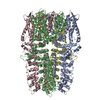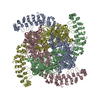[English] 日本語
 Yorodumi
Yorodumi- PDB-7ykr: Structure of TRPA1 in Drosophila melanogaster in a state with 17 ... -
+ Open data
Open data
- Basic information
Basic information
| Entry | Database: PDB / ID: 7ykr | |||||||||||||||
|---|---|---|---|---|---|---|---|---|---|---|---|---|---|---|---|---|
| Title | Structure of TRPA1 in Drosophila melanogaster in a state with 17 ankyrin repeats determined | |||||||||||||||
 Components Components | Transient receptor potential cation channel subfamily A member 1 | |||||||||||||||
 Keywords Keywords | MEMBRANE PROTEIN / ion channel / TRPA1 | |||||||||||||||
| Function / homology |  Function and homology information Function and homology informationcellular response to pulsatile fluid shear stress / temperature compensation of the circadian clock / negative phototaxis / detection of hot stimulus involved in thermoception / TRP channels / neuronal signal transduction / thermosensory behavior / temperature-gated cation channel activity / mechanosensory behavior / detection of chemical stimulus involved in sensory perception of bitter taste ...cellular response to pulsatile fluid shear stress / temperature compensation of the circadian clock / negative phototaxis / detection of hot stimulus involved in thermoception / TRP channels / neuronal signal transduction / thermosensory behavior / temperature-gated cation channel activity / mechanosensory behavior / detection of chemical stimulus involved in sensory perception of bitter taste / detection of chemical stimulus involved in sensory perception of pain / thermotaxis / detection of temperature stimulus involved in thermoception / cation channel complex / ligand-gated monoatomic ion channel activity / monoatomic cation transmembrane transport / detection of temperature stimulus involved in sensory perception of pain / response to light stimulus / monoatomic cation transport / phototransduction / monoatomic cation channel activity / positive regulation of calcium-mediated signaling / calcium channel activity / calcium ion transport / cellular response to heat / response to heat / membrane / plasma membrane Similarity search - Function | |||||||||||||||
| Biological species |  | |||||||||||||||
| Method | ELECTRON MICROSCOPY / single particle reconstruction / cryo EM / Resolution: 3.2 Å | |||||||||||||||
 Authors Authors | Sun, L. / Liu, X. / Yang, Z. / Wang, X. | |||||||||||||||
| Funding support |  China, 4items China, 4items
| |||||||||||||||
 Citation Citation |  Journal: Cell Discov / Year: 2023 Journal: Cell Discov / Year: 2023Title: Molecular architecture and gating mechanisms of the Drosophila TRPA1 channel. Authors: Xiaofei Wang / Yawen Li / Hong Wei / Zhisen Yang / Rui Luo / Yongxiang Gao / Wei Zhang / Xin Liu / Linfeng Sun /  Abstract: The transient receptor potential channel subfamily A member 1 (TRPA1) ion channel is an evolutionary conserved polymodal sensor responding to noxious temperature or chemical stimuli. Notably, the ...The transient receptor potential channel subfamily A member 1 (TRPA1) ion channel is an evolutionary conserved polymodal sensor responding to noxious temperature or chemical stimuli. Notably, the thermosensitivity of TRPA1 varies among different species or even different isoforms in the same species. However, the underlying molecular basis of its thermo-gating remains largely unknown. Here, we determine the structures of a heat-sensitive isoform of TRPA1 in Drosophila melanogaster in two distinct conformations with cryo-samples prepared at 8 °C. Large conformational changes are observed in the ankyrin repeat domain (ARD) and the coiled-coil domain between the two states. Remarkably, all 17 ankyrin repeats are mapped in the newly resolved conformation, forming a propeller-like architecture. Two intersubunit interfaces are identified in the amino (N)-terminal domain, and play vital roles during both heat and chemical activation as shown by electrophysiological analysis. With cryo-samples prepared at 35 °C, only one conformation is resolved, suggesting possible state transitions during heat responses. These findings provide a basis for further understanding how the ARD regulates channel functions, and insights into the gating mechanism of TRPA1. | |||||||||||||||
| History |
|
- Structure visualization
Structure visualization
| Structure viewer | Molecule:  Molmil Molmil Jmol/JSmol Jmol/JSmol |
|---|
- Downloads & links
Downloads & links
- Download
Download
| PDBx/mmCIF format |  7ykr.cif.gz 7ykr.cif.gz | 707.4 KB | Display |  PDBx/mmCIF format PDBx/mmCIF format |
|---|---|---|---|---|
| PDB format |  pdb7ykr.ent.gz pdb7ykr.ent.gz | 572.6 KB | Display |  PDB format PDB format |
| PDBx/mmJSON format |  7ykr.json.gz 7ykr.json.gz | Tree view |  PDBx/mmJSON format PDBx/mmJSON format | |
| Others |  Other downloads Other downloads |
-Validation report
| Summary document |  7ykr_validation.pdf.gz 7ykr_validation.pdf.gz | 1.3 MB | Display |  wwPDB validaton report wwPDB validaton report |
|---|---|---|---|---|
| Full document |  7ykr_full_validation.pdf.gz 7ykr_full_validation.pdf.gz | 1.3 MB | Display | |
| Data in XML |  7ykr_validation.xml.gz 7ykr_validation.xml.gz | 107.5 KB | Display | |
| Data in CIF |  7ykr_validation.cif.gz 7ykr_validation.cif.gz | 167.2 KB | Display | |
| Arichive directory |  https://data.pdbj.org/pub/pdb/validation_reports/yk/7ykr https://data.pdbj.org/pub/pdb/validation_reports/yk/7ykr ftp://data.pdbj.org/pub/pdb/validation_reports/yk/7ykr ftp://data.pdbj.org/pub/pdb/validation_reports/yk/7ykr | HTTPS FTP |
-Related structure data
| Related structure data |  33895MC  7yksC M: map data used to model this data C: citing same article ( |
|---|---|
| Similar structure data | Similarity search - Function & homology  F&H Search F&H Search |
- Links
Links
- Assembly
Assembly
| Deposited unit | 
|
|---|---|
| 1 |
|
- Components
Components
| #1: Protein | Mass: 135324.359 Da / Num. of mol.: 4 Source method: isolated from a genetically manipulated source Source: (gene. exp.)   Homo sapiens (human) / Strain (production host): HEK293F / References: UniProt: Q7Z020 Homo sapiens (human) / Strain (production host): HEK293F / References: UniProt: Q7Z020Has protein modification | Y | |
|---|
-Experimental details
-Experiment
| Experiment | Method: ELECTRON MICROSCOPY |
|---|---|
| EM experiment | Aggregation state: PARTICLE / 3D reconstruction method: single particle reconstruction |
- Sample preparation
Sample preparation
| Component | Name: Homotetramer of dTRPA1 / Type: COMPLEX / Entity ID: all / Source: RECOMBINANT |
|---|---|
| Molecular weight | Experimental value: NO |
| Source (natural) | Organism:  |
| Source (recombinant) | Organism:  Homo sapiens (human) Homo sapiens (human) |
| Buffer solution | pH: 7.4 |
| Specimen | Embedding applied: NO / Shadowing applied: NO / Staining applied: NO / Vitrification applied: YES |
| Vitrification | Cryogen name: ETHANE |
- Electron microscopy imaging
Electron microscopy imaging
| Experimental equipment |  Model: Titan Krios / Image courtesy: FEI Company |
|---|---|
| Microscopy | Model: FEI TITAN KRIOS |
| Electron gun | Electron source:  FIELD EMISSION GUN / Accelerating voltage: 300 kV / Illumination mode: SPOT SCAN FIELD EMISSION GUN / Accelerating voltage: 300 kV / Illumination mode: SPOT SCAN |
| Electron lens | Mode: DIFFRACTION / Nominal defocus max: 2300 nm / Nominal defocus min: 1500 nm |
| Image recording | Electron dose: 50 e/Å2 / Film or detector model: GATAN K2 SUMMIT (4k x 4k) |
- Processing
Processing
| CTF correction | Type: NONE |
|---|---|
| 3D reconstruction | Resolution: 3.2 Å / Resolution method: FSC 0.143 CUT-OFF / Num. of particles: 74515 / Symmetry type: POINT |
 Movie
Movie Controller
Controller



 PDBj
PDBj